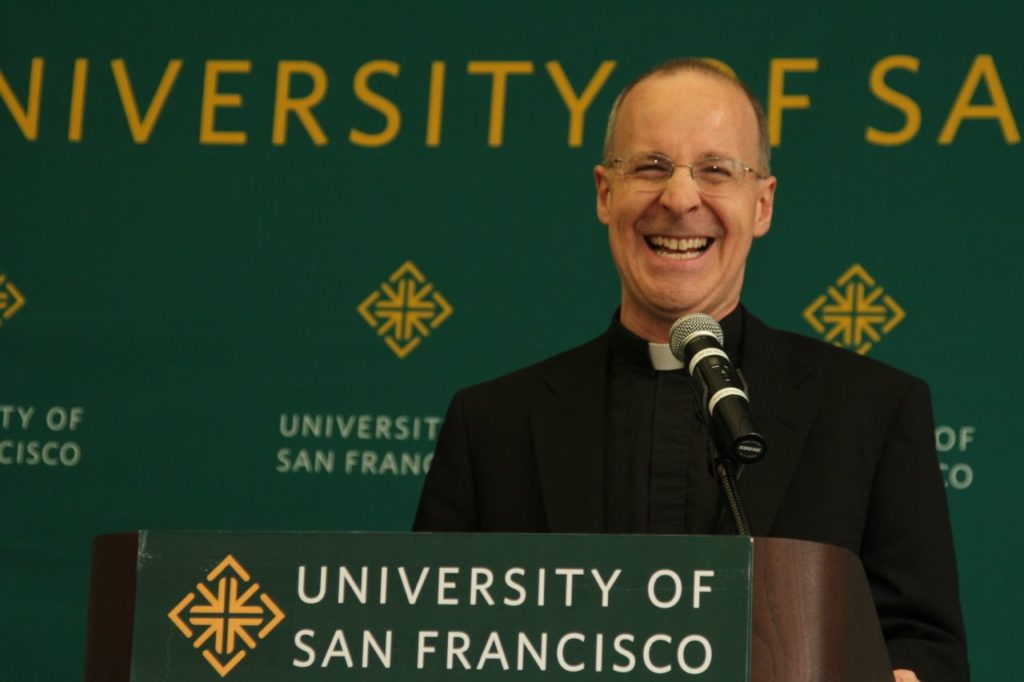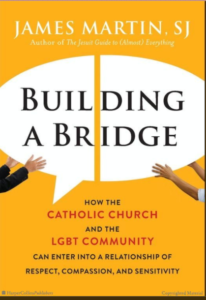With his new book Building A Bridge, Father James Martin charts a path for the LGBT community and the Catholic Church to “enter into a relationship of respect, compassion, and sensitivity.” Father Martin is an American Jesuit priest and editor-at-large of Jesuit magazine America. Below are two different responses to Building a Bridge.
A Prophetic Call? by Joshua Cayetano
Father James Martin has a prophetic message for the Catholic Church and the LGBT community. Like most prophetic messages it includes a rebuke, an uncomfortable truth, and a call to action.
Rebuke. While rebuke may be too stern a word for Fr. Martin’s compassionate tone, his message is a tough pill to swallow. Fr. Martin explains the impetus for Building a Bridge was the purportedly silent reaction to the Orlando nightclub shooting by many clergy. “Even in tragedy [LGBT] members are invisible,” he writes. Too long the Church has ducked its head and covered its eyes instead of addressing LGBT persons with charity, he contends.
An Uncomfortable Truth. Citing the Catechism, Fr. Martin argues “selectivity of focus on LGBT matters when it comes to firings is….‘a sign of unjust discrimination.’” All he asks is consistency. “Do we fire women who bear children out of wedlock? How about those living together without being married? Do we give pink slips to those who practice birth control?” More provocatively: “[What about] for not helping the poor, for not being forgiving, or for not being loving?”
Per Catholic doctrine, each of these are acts requiring repentance and forgiveness. With these comparisons, Fr. Martin is pointing to the stigmatization of LGBT persons that unjustly condemns their “trials” while normalizes other’s. Marriage after divorce without annulment, sexual relations out of wedlock, and even masturbation are all “chronic” sins yet do not receive nearly the amount of hatred, vitriol, or condemnation as directed at LGBT people.
Call to Action. The majority of Building a Bridge calls the institutional Church and the LGBT community to enter into a relationship of “respect, compassion, and sensitivity” per the Catechism. Fr. Martin addresses the institutional Church then the LGBT Catholic community, explicating for each what “respect, compassion, and sensitivity” looks like in concrete terms. For example, he calls on Catholic clergy to “call each group what it asks to be called” and for LGBT Catholics to seek understanding and not repay “supposedly un-Christian attitudes” with un-Christian attitudes themselves.
The remainder of the book (about 70 pages) is a compilation of Bible verses, parables, and questions for both parties to meditate and pray about. Building a Bridge is itself rooted in the Scripture and Catholic doctrine, and Fr. Martin ties in every point to a specific text.
Building a Bridge rings the most true when Fr. Martin sticks to Catholic authority and tradition, using Catholic teachings to point out the shortcomings of the Church and the LGBT community’s practice and charity. But Fr. Martin occasionally threatens to uproot his own source of authority by critiquing the language of the Catechism, such as when he objects to the Catechism’s description of homosexual persons as “needlessly harmful.” These objections cede doctrinal ground in favor of sentiment—an error Fr. Martin managed to avoid for the majority of his work.
Critics might argue Building a Bridge is half hand-waving to obscure differences and half fluff to temper the sharp sword of doctrine for the sake of “sinners.” Respect, compassion, and sensitivity are indeed airy terms. Yet Father Martin fills those sentiments with Scripture and tethers them to personal stories, practical wisdom, and honest relationship.
Father James Martin envisions a two-way bridge which requires the efforts of both parties. If the Church and the LGBT community took half the suggestions offered in Building a Bridge, it could inject a much-needed dose of charity into a divisive, complex issue.
The Bridge is Already Built by Hannah Lutz
While it is necessary for the Catholic Church to face the reality of LGBT persons and gracefully respond, Father James Martin in Building a Bridge ultimately fails to provide a cohesive solution to the divide.
Fr. Martin rightly reminds readers that all human beings are made in the image of God though tainted with sin. A Christian should not forget that though one may not struggle with same-sex attraction everyone struggles with sin.
Building a Bridge does not give a substantial explanation for the Catholic Church’s stance on homosexuality which is rooted in Natural Law. Catholicism holds Natural Law as a true doctrine to describe God’s intended way for humanity. According to the Catechism of the Catholic Church Natural Law is:
…written and engraved in the soul of each and every man, because it is human reason ordaining him to do good and forbidding him to sin. But this command of human reason would not have the force of law if it were not the voice and interpreter of a higher reason to which our spirit and our freedom must be submitted.
Father Martin fails to emphasize that all sin is a violation of Natural Law, therefore all sexual immorality is also a violation of Natural Law. For Catholics it is not same-sex attraction that is sinful in itself, but like other sins it’s acting upon these temptations that is sinful. Fr. Martin disapproves of Christians honestly telling the LGBT community to stop sinning, but instead recommends living in community with them first. However, coddling the immoral actions of anyone is a disservice to the sinner.
Respect, according to Fr. Martin, would entail the Catholic Church calling the LGBT community what they are asked. He writes, “Catholics have a responsibility to make everyone feel visible and valuable.” As Christians, our identity is in Christ not a gender, race, nationality, nor sexual orientation.
The end of Building a Bridge invites his readers “to walk on a bridge built from the three pillars of the Catechism’s approach to LGBT ministry: “’respect, compassion, and sensitivity.’ He writes this bridge is rocky because people in the church are not perfect.
In my opinion, The Catholic Church should not alter any of their teachings on homosexuality. It should welcome the LGBT community when they decide to shed their sexual orientation identity and welcome children of God as their new identity.
Building a Bridge presents some insightful arguments in challenging the Catholic Church to be more consistent with their teachings and anti-discriminatory rhetoric regarding the LGBT community. But Building a Bridge focuses more on appeasement than constructing an honest assessment of the relationship between the Catholic Church and the LGBT community. Ultimately, it fails to emphasize that there is already a bridge between the LGBT community and the Catholic Church: the Cross.






Comment by melanie statom on July 28, 2017 at 4:42 pm
While we were yet “sinners” Christ came and entered under our earthly “roof” and broke bread with saints and sinners. His bodily presence, in words and deeds reveal how he met people of all kinds…He is the definitive ” Christian dogma and theology” given us in living flesh. He transfigures our limited human understanding of ‘worthiness” regarding the “qualifications” of who gets to come close…” this day…the one you least expect, you know, that ” unworthy one” one…suffering on a cross with him, may be with him in paradise”, saved by the boundless love and mercy of the God Jesus reveals as love.